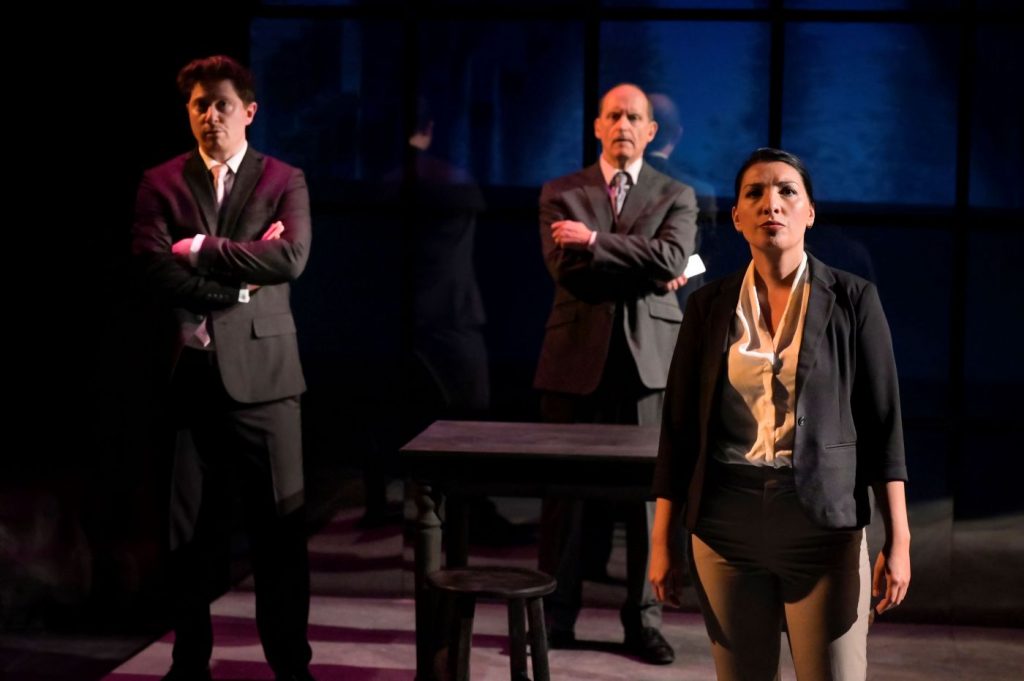In recent years many theater companies have made a point of introducing performances with land acknowledgements, thanking the Native peoples whose ancestral lands the theater occupies — lands that were generally taken from them by force.
In the case of “Manahatta” at Berkeley’s Aurora Theatre Company, the whole play serves as a land acknowledgement of sorts.
Mary Kathryn Nagle’s drama jumps back and forth between Wall Street in the early 2000s and the same land in the 1600s when it was known as Manahatta, the home of the Lenape people.
“Manahatta” premiered at the Oregon Shakespeare Festival in 2018 and played New York’s Public Theater (in Manahatta itself) last November. Also a lawyer and citizen of the Cherokee Nation, Nagle had the West Coast premiere of her play “Sovereignty” at Marin Theatre Company in 2019.
The play follows Jane Snake, a young Lenape woman who grew up in Oklahoma after many generations of displacement, as she rises through the ranks at a major Wall Street investment bank in the years leading up to the 2008 financial crisis.
As played by Livia Gomes Demarchi, Jane radiates confident professionalism mixed with workaholic deference to the unreasonable expectations heaped on her by her bosses, Max Forman-Mullin as brusque, demanding young department head Joe and Anthony Fusco as smoothly callous CEO Dick. They appreciate Jane in direct proportion to how much money she makes them, and if she falls short they have no use for her.
Back in Oklahoma, Jane’s mother is struggling financially and falling prey to the same kind of predatory lending that Jane’s company is profiting from. Portrayed with placid stoicism by Linda Amayo-Hassan, mother Bobbie is too proud to ask for advice or even let her family know what’s going on. As older sister Debra, Oogie Push is resentful of Jane’s absence but resigned to get on with whatever needs to be done.
Victor Talmadge is cloyingly solicitous as a local banker (and seemingly also pastor) offering dubious financial assistance and trying to woo Bobbie back to the local church. Reprising roles played both at OSF and at Yale Repertory Theater, Ixtlán is sweetly attentive as Luke, the White banker’s adoptive Lenape son, who carries a torch for Jane.
There’s a whole sub-thread about trying to preserve the Lenape language that was systematically and literally beaten out of the community in years past, and in the 1600s scenes we see the groundwork for that erasure being laid by the Dutch colonists.
Ixtlán is particularly compelling as Se-ket-tu-may-qua, a young Lenape man who’s learned the settlers’ language (or who simply “can speak,” as they put it) to trade hand-prepared furs for wampum. Demarchi’s Le-le-wa’-you is a curious and enterprising young woman who sets out to do the same. Amayo-Hassan appears as an imposingly impassive matriarch, and Push makes an appearance as a more vaguely defined 17th-century version of Jane’s sister.
We know with hindsight that the colonists represent nothing but trouble, even as Forman-Mullin makes seemingly sincere friendly overtures as Dutch trader Jakob. Fusco is the very embodiment of cold, voracious greed as Peter Minuit of the Dutch West India Company, tricking the Lenape into “selling” them the land when they don’t know what they’re supposedly agreeing to. And when things very quickly turn bad, they get downright horrific.
Talmadge also appears as the first clergyman in the colony, setting out to convert the Native people, a character who makes an entrance as if he’s going to be much more relevant to the story than he ever becomes.
Ultimately, though, the play is less about the characters than the arc of history and the direct line between the avarice of colonialism and the predatory capitalism of today.
The parallels between characters and situations are often chilling, particularly when whole bits of dialogue are repeated over the ages, illustrating how little some of the ways that people are taken advantage of have changed.
At the same time, occasionally an echoed line makes a 21st-century character sound curiously unfamiliar with a concept that one would think they’d encountered before (home ownership, brandy), while their 17th-century doppelgangers almost certainly haven’t.
The connection becomes more and more concrete as director Shannon R. Davis’ gripping staging goes on, with James Ard’s sound design ramping up the tension at critical moments. Asa Benally’s costumes switch from one era to another with minimal changes, and sometimes actors shift back and forth without costume changes at all as the timelines begin to bleed into each other. Deanna L. Zibello’s set is effectively minimal — an uneven tiled floor, a small writing desk and stools— with Wolfgang Wachalovsky’s video design setting the scene from cityscapes to rivers and reeds.
There are some slow spots, with the plain-spoken dialogue occasionally seeming didactic, and the ending is curiously anticlimactic after the catastrophic events leading up to it. Then again, if there’s one thing the play’s Native protagonists have a lot of practice with, we’re told, it’s picking up and carrying on after calamity.
On the whole “Manahatta” provides a forceful history lesson that puts the dominant narrative of the roots of this nation into much-needed perspective.
Contact Sam Hurwitt at [email protected], and follow him at Twitter.com/shurwitt.
‘MANAHATTA’
By Mary Kathryn Nagle, presented by Aurora Theatre Company
Through: March 10
Where: Aurora Theatre, 2081 Addison St., Berkeley (available for streaming March 5-10)
Running time: One hour and 45 minutes, no intermission
Tickets: $20-$65; 510-843-4822, www.auroratheatre.org


